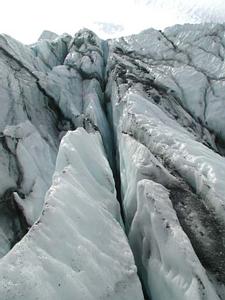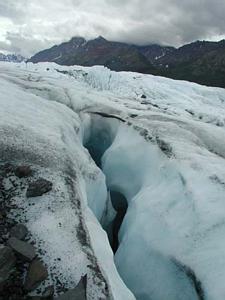4 August, 2000
August 4 , 2000
Matanuska Glacier, Alaska
This morning we woke up to rain for the first time in quite awhile.
Several of us had stayed up very late last night to watch for the
northern lights under nice clear skies and decent temperatures. At about
1:30 am clouds moved in to block any chance of seeing it just as it was
about dark enough for viewing. Overnight the clouds continued to develop
into light showers. The threatening morning weather forced Bob Bigl to
postpone his drilling so I went to North Vent with a couple others to
retrieve the water samples from the ISCO. Iíve been asked by a number of
people what ISCO stands for and no one here seems to know. We even
pulled the manual out to look but to no avail. Iím guessing it is just
the name of the company. After fixing lunch we all headed to Wasilla
once again for showers, laundry and groceries. We also learned that the
dye has come in and we plan to resume our dye tests soon using the
moulin originally used in our salt tests.
It seems that the moulins weíve watched develop tend to form where there
is an existing crack in the ice. There are lots of cracks all over the
glacier but some of them open up to form long deep fissures called
crevasses. Crevasses can be over one hundred feet deep and several feet
wide. As a glacier flows the upper 100-150 feet of ice is more brittle
than that below. Below this depth the ice is under much more pressure
and deforms and flows plastically. Due to the differential speeds in the
flow of the ice (slower at increasing depth) this upper layer tends to
crack open forming crevasses which may extend hundreds to thousands of
feet across the glacierís surface. Crevasses are one of the earliest
structural features to form in a glacier and are found along the entire
length from head to terminus. They often change size and shape as the
glacier moves down the valley. They form perpendicular to the direction
of stretching similar to cracks on a stretched rubber band. Along the
length of the glacier they are generally perpendicular to the flow
direction in the valley. They are more numerous in areas where the slope
is steeper causing an increase in flow velocity.
Crevasses may be described in terms of their orientation to the glacier.
They may also be described in terms of their location such as marginal,
central or terminal. Transverse crevasses extend across a glacier and
are due to the steepening of the glacierís slope. Longitudinal crevasses
form where the glacier is spreading out laterally, most commonly near
the terminus. They can also form in the central part if the ice stream
but they will usually curve around into an oblique orientation near the
margins. I see mostly longitudinal crevasses around the terminus here on
the Matanuska Glacier. On a recent hike up the glacier I could see
transverse crevasses as well.
I never seem to pass up the opportunity to gaze down into crevasses.
There are always many beautiful shades of blue which is especially
prominent on overcast days. Usually there are sounds of running or
dripping water to be heard and in some of the larger deeper ones you can
listen to groanings of the glacier that may originate miles away. They
are certainly interesting features to explore and enjoy.
Marvin Giesting

My partner Ben enjoys a view over a small crevasse.


Crevasses are found everywhere on the glacier including moraines which just happen to be debris covered ice.

Contact the TEA in the field at
.
If you cannot connect through your browser, copy the
TEA's e-mail address in the "To:" line of
your favorite e-mail package.
|
